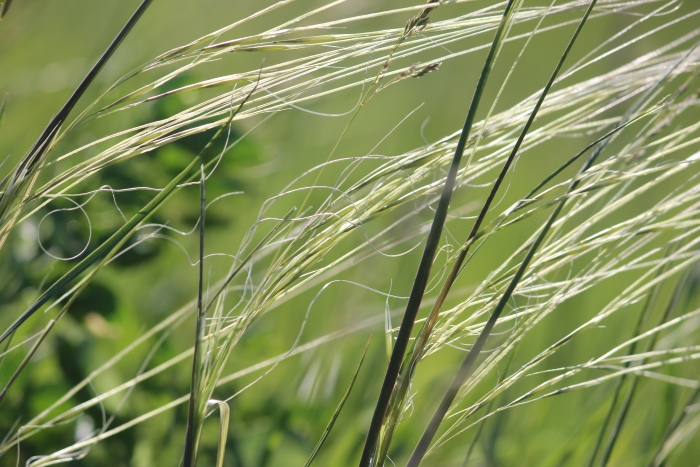Porcupinegrass
(Stipa spartea)
Porcupinegrass (Stipa spartea)
/
/

USFWS Mountain-Prairie
Public domain
Image By:
USFWS Mountain-Prairie
Recorded By:
Copyright:
Public domain
Copyright Notice:
Photo by: USFWS Mountain-Prairie | License Type: Public domain | License URL: https://creativecommons.org/public-domain/ | Uploader: Holly Cheng | Publisher: Wikimedia Commons | Title: Porcupine_Grass_(Closeup)_(14258034487).jpg | Notes: |

















































Estimated Native Range
Summary
Stipa spartea, commonly known as Porcupinegrass, is a semi-deciduous perennial grass native to the tallgrass prairies and open woodlands of central North America. It forms a dense bunchgrass foliage mass of 3–6 feet (0.91–1.83 m) in diameter and can reach over a meter in height. The flower stalks are upright and arching, displaying yellow inflorescences in late spring. Porcupinegrass is distinguished from similar species like needle-and-thread grass by its longer, wider, and paler leaves. The roots are notably deep, reaching up to 1.8 meters (5.9 feet) into the soil, which helps the plant withstand drought conditions.
Porcupinegrass is valued for its unique seed dispersal mechanism, geocarpy, where the awns twist or untwist in response to temperature and moisture changes, drilling the seeds into the soil. This adaptation, along with the sharp, needle-like seeds and backward-facing hairs, ensures effective self-planting. The species is used in native plant gardens, natural landscaping, and habitat restoration projects in the Great Plains—Prairie region. It thrives in full sun and is adaptable to a range of soil types, preferring medium to fast drainage with low to medium water requirements. While it is low-maintenance, care should be taken as the sharp seeds can be a nuisance and may cause injury to pets and humans.CC BY-SA 4.0
Porcupinegrass is valued for its unique seed dispersal mechanism, geocarpy, where the awns twist or untwist in response to temperature and moisture changes, drilling the seeds into the soil. This adaptation, along with the sharp, needle-like seeds and backward-facing hairs, ensures effective self-planting. The species is used in native plant gardens, natural landscaping, and habitat restoration projects in the Great Plains—Prairie region. It thrives in full sun and is adaptable to a range of soil types, preferring medium to fast drainage with low to medium water requirements. While it is low-maintenance, care should be taken as the sharp seeds can be a nuisance and may cause injury to pets and humans.CC BY-SA 4.0
Plant Description
- Plant Type: Grass
- Height: 2-4 feet
- Width: 0.5-1 feet
- Growth Rate: Moderate
- Flower Color: N/A
- Flowering Season: Spring
- Leaf Retention: Semi-Deciduous
Growth Requirements
- Sun: Full Sun
- Water: Medium
- Drainage: Medium, Fast
Common Uses
Deer Resistant, Erosion Control, Fire Resistant, Low Maintenance
Natural Habitat
Native to the tallgrass prairies and open woodlands of central North America
Other Names
Common Names: Western Porcupine Grass, Short-Awn Porcupine Grass, Porcupine Needlegrass, Big Needlegrass
Scientific Names: , Stipa spartea, Hesperostipa spartea, Stipa robusta, Hesperostipa curtiseta, Stipa curtiseta, Stipa spartea var. curtiseta, Stipa spartea subsp. curtiseta, Stipa spartea var. spartea,
GBIF Accepted Name: Stipa spartea Trin.